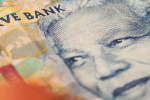Recession fears fade as South Africa's GDP data show growth
 South Africa recession fears fade as the economy rebounded, with gross domestic product (GDP) data for the second quarter of 2016 showing growth of 3.3%.
South Africa recession fears fade as the economy rebounded, with gross domestic product (GDP) data for the second quarter of 2016 showing growth of 3.3%.
PRETORIA - South Africa recession fears fade as manufacturing and mining sectors output rebounded, with the gross domestic product (GDP) data for the second quarter of 2016 showing growth of 3.3%.
This follows a dismal first quarter, where the economy declined by 1.2%. This marks the fastest pace of growth for South Africa since 2014, Statistics South Africa (Stats SA) said in a report released on Tuesday.
The largest positive contributor to growth in GDP in the second quarter was manufacturing, which increased by 8.1% and contributed 1.0 percentage point to GDP growth.
"We hope that these signs of growth are an early indication that the manufacturing sector, which is essentially still fragile, can move towards stabilising and strengthening. We, however, always need to be cognisant of external factors which impact on local and global demand and, therefore, manufacturing output," industry body Manufacturing Circle executive director Philippa Rodseth said.
Mining and Quarrying recovered in the second quarter, increasing by 11.8% and contributing 0.8 of a percentage point to GDP growth.
Finance, Real Estate and Business Services increased by 2.9% and contributed 0,6 of a percentage point to GDP growth.
Statistics South Africa (Stats SA) Deputy Director-General Joe de Beer said in nominal terms, the GDP growth is estimated at R1 068 billion for the second quarter of 2016, which is R25 billion more than the first quarter of 2016.
Finance Minister Pravin Gordhan told a South African Chamber of Commerce and Industry meeting on Tuesday that he was "a little optimistic" about economic growth in the second quarter following a 1.2% decline in the first quarter.
Economists, however, warn that while the improvement is welcome, headwinds remain for the sector because commodity prices and demand have yet to fully recover.
Conditions for manufacturers remained tough, particularly given the prospect of a strike in the sector, First National Bank senior industry analyst Jason Muscat said.
He expected manufacturing data for the rest of 2016 to "be choppy, even in the absence of strikes".
Nedbank economist Busisiwe Radebe agreed, saying that although the better-than-expected production data in May were encouraging, conditions were expected to remain subdued in 2016.
Manufacturing production, like mining, was likely to continue being adversely affected by low commodity prices that were unlikely to "reverse convincingly" in the next few months, Radebe said. Considerable global excess capacity and rising domestic production costs would also affect production negatively.
Although manufacturing output is expected to remain under pressure in coming months, a key leading indicator of activity in the sector suggests that production increased again in June. The Barclays purchasing managers’ index rose to 53.7 index points in June from 51.9 in May. An above-50 reading signifies improvement in manufacturing activity.
The manufacturing and mining sectors have been in decline for the past few years and have been the sectors to lose the most jobs.
"The manufacturing sector remains fragile, and in this environment, we hope to see as many jobs retained in the short term as possible," Rodseth said.
The rand strengthened against the major currencies – firming 1.15% against the dollar to R14.21. It was also 1.0% firmer against both the euro and British pound, at R15.86 and R18.91 respectively.









![Fitch Ratings holds off on downgrading South Africa's credit rating at investment grade but warned that political and growth concerns posed a risk. [IMAGE] EFF MPs fight with security services who were ordered to throw them out of parliament recently](https://www.sacommercialpropnews.co.za/thumbnail.php?file=articles/EFF_out_of_parliament_610911998.jpg&size=summary_large)







